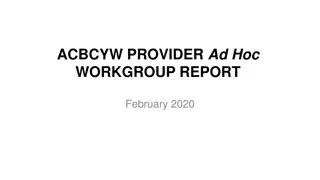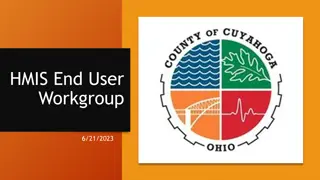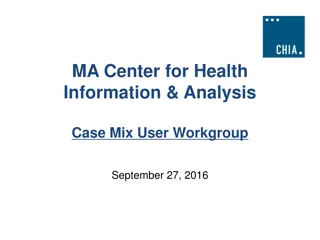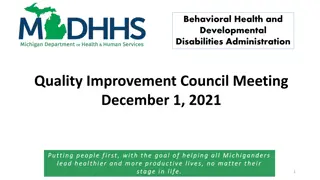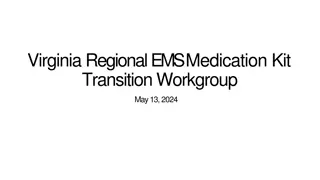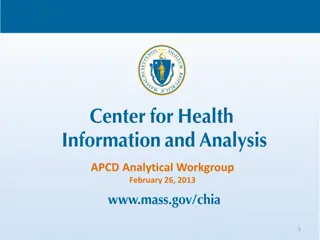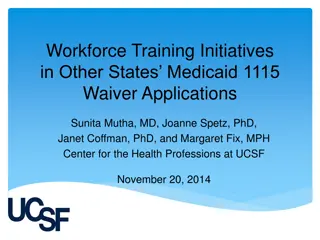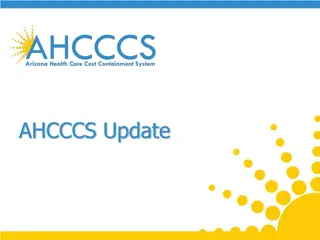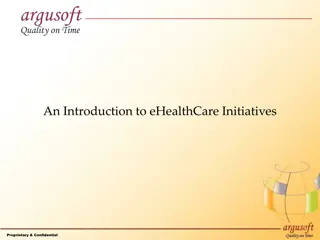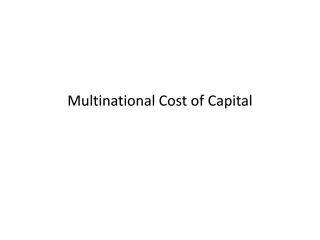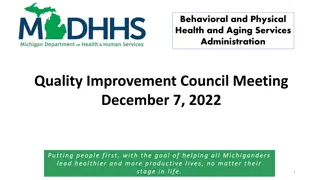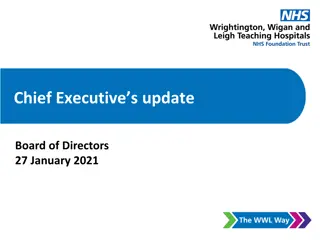Healthcare Cost Workgroup Initiatives and Strategies Update
Healthcare Cost Workgroup, funded by the Maine State Innovation Model Initiative, focuses on reducing healthcare costs through actionable strategies. The group meets monthly with a diverse range of participants and prioritizes price, delivery system infrastructure, and consumer engagement. They have identified savings opportunities, reviewed price reduction strategies, and are moving forward with risk-based contracts and transparency initiatives.
Download Presentation

Please find below an Image/Link to download the presentation.
The content on the website is provided AS IS for your information and personal use only. It may not be sold, licensed, or shared on other websites without obtaining consent from the author. Download presentation by click this link. If you encounter any issues during the download, it is possible that the publisher has removed the file from their server.
E N D
Presentation Transcript
Cost of Care Update Payment Reform Subcommittee October 21, 2014 This work is made possible with funding from the Maine State Innovation Model Initiative
Cost of Care Activities Healthcare Cost Workgroup CEO Summit Healthcare Data Book 2
Healthcare Cost Workgroup Meeting monthly since April; group next meets on October 30 40-50 participants at each meeting; open to all; outreach ongoing Balanced participation; participating organizations include: BIW, Bates College, Maine Municipal Association, University of Maine, Maine Education Association Benefits Trust, State Employee Health Commission, Catholic Charities, Norway Savings, MaineCare Central Maine Medical, Eastern Maine Health, MaineHealth, Mercy Hospital, Mayo, Franklin Memorial, St. Mary s, St. Joseph, Redington Fairview, Martin s Point, Sacopee Valley Health Center, Mid Coast Health, Maine Primary Care Association, Maine Network for Health, Spurwink, Sweetser, Tri-County Mental Health, Maine Medical Association, Maine Hospital Association Aetna, Anthem, Cigna, Harvard Pilgrim, Maine Community Health Options, Maine Association of Health Plans Behavioral Healthcare Cost subgroup has met twice, with approximately 20 stakeholders at each meeting; last met on October 8, next meets on December 17 3
Healthcare Cost Workgroup Objectives Identify actionable strategies to reduce healthcare costs First deliverable: develop a specific operational plan for pursuing one or more identified savings opportunities presented recommendation on risk-based contracts with voluntary growth caps at CEO Summit earlier this month 4
Workgroup Process Step 1: Identify Savings Opportunities At initial meeting, participants discussed potential savings opportunities, including those identified by 2012 workgroup as well as additional recommendations from the current workgroup General support for all options, but group voted to focus early attention on: Price Delivery system infrastructure Consumer engagement 5
Workgroup Process Step 2: Review Price Options Workgroup participated in presentation and discussion of a range of price reduction strategies to determine what strategies participants are interested in pursuing Reviewed options included: transparency reference pricing narrow networks bundled payments risk-based contracts with voluntary growth caps rate setting Participants identified priorities: Risk-based contracts with voluntary growth caps Transparency 6
Price Transparency Tools Price calculators allow consumers to compare providers on price and quality; many also calculate consumers out-of-pocket costs Savings occur when consumers choose lower cost providers and when higher cost providers lower their prices Consumers often unaware of price variation in same market Patients using well-designed, easy-to-use tools to compare price and quality are more likely to choose high-value, lower priced providers In recent years, number and quality of tools has increased, with many employers using independent vendors such as Castlight and Wellmatch Despite increased availability, consumer utilization is low 98% of plans offer online calculators, but only 2% of patients with access to tools use them; uptake slightly higher among those with high deductibles Concerns: availability of quality data; potential impact on providers whose higher prices may result from cost shifting, complexity of care; may require benefit design changes to encourage consumers to seek out high- value providers 7
Reference Pricing Under reference pricing, plan sets maximum amount reference price for a procedure or drug Patients can choose any provider, but must pay the difference for a higher priced provider Typically used for non-emergency procedures where there is variation in price but not quality, such as joint replacement, imaging, colonoscopies, and pharmaceuticals Designated providers must meet price and quality standards 11% of large US employers used reference pricing in 2012, another 16 percent considering it State of California saw knee replacement costs drop 20%, as employees chose lower cost providers, and higher cost providers reduced prices; with robust employee education, CalPERS reported little employee resistance Concerns: Maine markets may not be big enough to ensure choice of quality providers; savings associated with reference priced services could be offset by increased utilization or price in other areas; some providers higher prices may be due to cost shifting or complexity of care; additional quality measures may be needed to identify quality providers 8
Narrow Networks Narrow networks limit enrollees to certain hospitals, doctors, and other providers Savings can result from using high-value, low-cost providers, and negotiating lower prices in exchange for increased volume 23% of employers who offer health benefits offer a narrow network option; narrow networks also common option on healthcare exchanges Concerns: excluded providers may offer unique services; Maine markets may be too small to ensure choice in a narrow network; patient care could be fragmented if some regular providers are out-of-network; consumers who inadvertently leave network could face large bills 9
Bundled Payments Episode-based payments that cover all services for a specific condition, illness, or medical event, including services from different providers in various settings Works well when there is cost variability and high volume of episodes Savings can result from standardizing care processes, resulting in improved coordination and integration among all providers caring for a patient; physicians also take more active role in pursuing cost saving strategies Interest in commercial market low, but growing Much of early focus on orthopedic episodes; expanding now to acute medical and chronic conditions (such as diabetes); other popular bundles include congestive heart failure, coronary artery bypass graft, COPD, bronchitis/asthma Concerns: expensive and complex to implement, providers may lack resources or capacity; there may not be sufficient volume in Maine to make bundled payments cost effective here; lower costs per episode could be offset by increased number of episodes; engaging nationally-based insurers may be a challenge 10
Risk-based Contracts with Voluntary Growth Caps Risk-based contracts set a per member budget that covers all services for each covered member Contracts can be designed so that providers share upside risk (shared savings) or also downside risk (shared risk), if spending exceeds agreed upon budget Risk-based contracts, typically ACOs, have been expanding rapidly, nationally and in Maine; generally provider-operated; insurance companies are also forming ACOs in partnership with providers Three Medicare shared savings projects and one Pioneer project underway in Maine; also a series of shared savings ACO arrangements in the commercial sector, covering both large self-insured plans and fully insured products A voluntary growth cap limits annual increases in the per member amount to an agreed upon cap (apart from price changes related to risk adjustment or benefit design changes) Concerns with risk-based contracts: will earned savings be sufficient to support necessary financial investments and system transformation; complex to implement 11
Regulated Pricing State regulates the amount of reimbursement hospitals receive for services, with hospitals charging all payers the same price for a given service; prices vary among hospitals due to population-based risk adjustments, local wage differences, etc. May include a volume adjustment system to limit volume growth, as well as financial support for uncompensated care Cost savings achieved by setting price levels and reducing administrative costs; provides predictable revenue stream Several states, including Maine, implemented rate setting in 1970s and 1980s, most discontinued by 1990s; today only Maryland and West Virginia programs still operating In several states, rate setting reduced cost per case; but increases in utilization could limit impact on total costs Concerns: unlikely the strategy would garner broad support, making required statutory change difficult to achieve; expensive to implement 12
Strategies to Advance Risk-based Contracts with Voluntary Growth Caps Participants identified strategies to advance risk-based contracts in Maine and constrain year-to-year growth: Technical assistance and learning collaboratives Standardization of some aspects of risk-based arrangements (such as measurement alignment) Voluntary growth caps Coupling risk-based contracts with voluntary growth caps ensures that efficiencies gained through population-based budgets are not lost through negotiated annual price increases Under a growth cap, negotiations take place in the context of an upper boundary on year-to-year growth Over time, such voluntary caps should improve affordability 13
Voluntary Growth Cap Options The workgroup reviewed several growth rate indices, including: Consumer Price Index (CPI)-All Urban: less food and energy CPI-All Urban: medical care Maine GDP Inpatient PPS Hospital Market Basket Participants favored an inflation-based index (CPI), which is based on consumer spending and is more stable than some other indices Retrospective CPI estimates are calculated by the U.S. Bureau of Labor Statistics; projections are forecast by private firms, including leading forecaster Moody Analytics, used by Maine state economist Some participants supported CPI-All Urban: less food and energy, which is the most commonly used measure of general inflation in the economy; others preferred CPI-All Urban: medical care 14
Voluntary Growth Cap Index Options 2004 2005 2006 2007 2008 2009 2010 2011 2012 2013 CPI-All Urban: less food and energy 1.8% 2.2% 2.5% 2.3% 2.3% 1.7% 1.0% 1.7% 2.1% 1.8% CPI-All Urban: medical care 4.4% 4.2% 4.0% 4.4% 3.7% 3.2% 3.4% 3.0% 3.7% 2.5% Maine GDP (nominal) Inpatient PPS Hospital Market Basket 6.6% 2.8% 4.2% 2.6% 1.6% 0.3% 2.3% 0.6% 2.9% 2.9% 4.0% 4.0% 3.8% 3.6% 4.0% 2.1% 2.3% 2.7% 2.1% 1.9% 10.0% 9.0% CPI -All Urban: less food and energy 8.0% 7.0% CPI-All Urban: medical care 6.0% 5.0% Maine GDP (nominal) 4.0% 3.0% Inpatient PPS Hospital Market Basket 2.0% 1.0% 0.0%
Growth Cap Index Options 4.5% 4.0% 3.5% 3.0% 2.5% CPI-All Urban: medical care 2.0% 1.5% CPI-All Urban: less food and energy 1.0% 0.5% 0.0% 16 Note: CPI forecasts from Moody Analytics, provided by Maine State Economist Amanda Rector, 8/6/14. Forecasts updated monthly.
Recommendation Set the voluntary growth cap for 2015 at CPI-All Urban: medical care, and gradually decline by 2019 to CPI-All Urban: less food and energy plus 25% of the difference between the two indices Employers, providers, and plans participating in ACOs and other risk-based contracts will be asked to voluntarily limit annual risk-adjusted per member per month (PMPM) growth to no more than the agreed-upon cap Each ACO arrangement s specific growth rate under the voluntary cap will be established through ACO contract negotiations A safety valve will be available to modify growth caps if significant unanticipated events are likely to result in unexpected or unreasonable windfalls or losses to ACOs or purchasers/plans 17
Growth Cap Recommendation 4.5% CPI-All Urban: medical care 4.0% 3.5% 3.0% CPI-All Urban: less food and energy 2.5% 2.0% 1.5% Recommendation: Trend from CPI: medical care to CPI: less food & energy plus 25% of difference 1.0% 0.5% 0.0% 18 Note: CPI forecasts from Moody Analytics, provided by Maine State Economist Amanda Rector, 8/6/14. Forecasts updated monthly.
CEO Summit CEO Summit convened on October 2 Over 50 executives from across Maine attended, including many non-Coalition members Keynote speaker Alan Gilbert of GE discussed strategies for stakeholders to work together to improve quality and affordability, as well as importance of collaborative, multi-stakeholder approach, even for jumbo employers Healthcare Cost Workgroup deliberations and recommendation presented to Summit participants, including risk-based contract with voluntary growth cap To date, purchaser participant follow-up has yielded positive response to voluntary growth cap recommendation 19
Healthcare Data Book Semi-annual publication that provides a range of information on: demographics health status utilization and delivery of healthcare quality cost First edition presented at CEO Summit; printed copies available in 1-2 weeks 20


